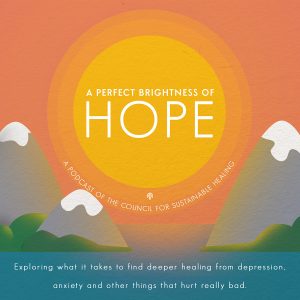Is It Time for a Paradigm Shift in Mental Health? and
If More Treatment Is the Answer, Why Haven’t the Numbers Gone Down?
Dr. Martin Seligman, the psychologist famous for introducing “learned helplessness” to the world, once proposed three characteristics that differentiate between pessimism and optimism:
- Personalization: Compared to those who see painful experiences as meaningfully connected to larger contexts, some come to believe such difficulties primarily arise from deficiencies inside oneself—e.g., “I must be just messed up.”
- Permanence: Compared to those who see painful experiences as temporary, some come to believe such difficulties will largely remain unchanged throughout one’s life—e.g., “It’s always going to be this way.”
- Pervasiveness: Compared to those who see painful experiences as coming and going, some come to believe such difficulties permeate all areas of life—e.g., “Everything is awful.”
Remarkably, these three qualities sum up remarkably well the predominant American narrative of depression and other mental health challenges: Rooted internally in the brain, enduring throughout the lifespan, and touching virtually every aspect of life. As one woman facing depression remarked: “I live with mental illness every moment of every day. It wasn’t always this way. I know how it feels to be happy and experience pure joy. I remember the anticipation and excitement of the new. I don’t feel those things any more. My brain doesn’t work properly.”
I first started noticing this pattern after conducting my own five-year interview study of depression over a decade ago—examining diverse manifestations of despair through the in-depth experiences of 16 men and women across the United States. Among the many findings, one in particular stood out. Above and beyond the acute pain of depression many people carry, some seem to be shouldering another kind of burden: one tied to uniquely despairing beliefs about depression—its nature, source, and prognosis. In what follows, I summarize the key features of this prevailing narrative in three parts:
1. Intrinsic internal deficiency. One central feature of the dominant American narrative of depression is the belief that emotional pain arises largely (and indeed, almost unilaterally) from one’s internal physiological make-up—a body that is fundamentally deficient, disordered, or defective in some way. As respected mindfulness teacher Thomas McConkie recounted: “When I was about 16 years old, I remember the first conversation I had with a psychiatrist about my brain and its role in my mental illness. He told me my brain was like a car engine without oil. And therefore, over time it would break down. It wasn’t able to do what it wanted to do because it didn’t have all the proper components there.”
The perception that you are inherently broken can play a measurable role in generating discouragement.
He recollected his response at the time: “I remember feeling dismayed—a little bit crushed that all of a sudden this brain that had made such a good companion to me for sixteen years of my tender life, that it was deficient, that it was kind of broken, that there was something we needed to prop it up with to make it kind of work. And all of these fearful thoughts come up, and your life transforms like that [snaps his fingers]. You go from having this [functioning] brain to having this busted up jalopy of a car that’s going to break down at any moment.”
Such fear is surely understandable. If your brain is fixed in a difficult place, that might just mean your future is as well. As one mother of a teenager facing depression told me: “His brain is wired in a way that his mental illness will be a monkey on his back the rest of his life. He needs to learn to live with it the best he can. I’m expecting him to regress. ”
In fairness, it makes good sense why we would search for some mechanism internally to explain the aching pain of something like depression. For at least a decade—up till the turn of the century—many brain scientists believed a “chemical imbalance” might explain what is happening. While there’s no question that configurations of chemicals play an ongoing role in our mental health, current neuroscience understandings have gone far beyond these early hypotheses. Indeed, most brain scientists have rejected the idea that mental illness arises from permanent states of chemical imbalance or deficiency in the brain (see this 2015 comparison of the scientific evidence and the popular rhetoric led by Dr. Jeff Lacasse at Florida State, along with earlier analyses of media claims here and here).
In line with updated biological explanations of the many ways the body can get legitimately dysregulated (hormonally, nutritionally, chemically, and from inflammation), there is growing appreciation for the possible scope of physiological change throughout our lifespan. Despite this, most people with mental illness continue to be told the same thing as before. In my own review of NAMI’s 400-page manual provided in their popular family education course, I found only a single mention of neuroplasticity as a “controversial” new theory—compared with frequent mentions of various kinds of chemical and genetic defects likely involved.
That’s not something people naturally come to believe; it’s something they are taught. Speaking of people who come to their mental health recovery programs, Ann Rider notes “they’re creative, they’re resilient, they’re survivors, they’re just amazing human beings. And yet they’ve been told they’re broken—and they believe that.”
Such a perception that you are inherently broken can play a measurable role in generating discouragement. Thomas McConkie elaborated on what his doctor’s specific “framing of symptoms” meant for him at the time: “Immediately, [it suggested this] ‘wasn’t a tough go at it,’ it wasn’t just ‘this season of challenge and unrest.’ It was, ‘this is your brain kid—this is how things are going to be.’ And I was upset; I felt deeply saddened by that prospect…I remember that was a sad day and I really carried that with me.”
There’s evidence to suggest that those who embrace a view of their own brain as deficient end up seeing their own prognosis as worse and feeling more pessimistic about the potential role of other non-medical treatments (something I observed in my own interviewing study as well). One woman reflected: “My brain is broken. I’ve got broken thoughts. I’ve been dreaming broken dreams. . . . I hate my broken brain.”
As Dr. Elisha Goldstein puts it: “Our brain really runs us in a lot of ways. And if something’s defective about it and we can’t change it, that would make it difficult for someone to feel a lot of hope.” Referring to these narratives of permanent dysfunction that many people continue to hear from well-intentioned professionals, Thomas summarized: “We think that’s a definitive statement about our body or our brain, and we tend to identify with that. And that can create kind of this claustrophobic feeling of, ‘I can only do so much about it because that’s what I am.’” Neuroscientist Amishi Jha agreed: “I think that if someone didn’t understand that the brain is capable of changing, it could leave you in a very suffocating, constrained feeling. It’s a hopeless feeling.”
2. Enduring, long-term illness. Closely associated with this narrative of permanent deficiency and dysfunction is a prognosis that is similarly enduring. Reflecting on her own diagnosis, one woman told me: “It’s like I was told, ‘this is something that’s going to be with me for good. It’s not a cold that’s just going to go away. This is me,’ you know—and that’s sad. You feel like you lose yourself, almost . . . This is not who I was supposed to be.”
In my study, I asked participants “Do you ever talk about ‘getting better’ from depression?” One woman said, “I don’t think that’s possible. I just . . . I want to, but I don‘t think that I . . . I think, just a couple years ago, I just faced it that I‘m just always gonna have to have something.”
To have someone tell you that what you have is a condition that you’re going to have to live with the rest of your life, it makes you feel even more hopeless, more in despair.
Another said, “Is there a getting better from this or not? I mean, they told me in the beginning there wasn’t. But I’m hoping that I can make improvements that are permanent . . . I am getting better than I was, certainly. I don’t know how much better, you know?”
I asked this second individual, “Who told you that you don’t get better?” She responded, “Well my initial diagnosis—they said this is something permanent. They told me, ‘This isn’t something that you’ll ever not have.’”
Another person recounted: “The diagnosis I was given at the time was bipolar disorder. The doctors all through had all said that this was something that was chronic, it was something that was debilitating. It was something that as I got older, it would get worse.”
This kind of a narrative shows up across all ages—with one mother of a struggling 16-year-old girl telling me: “You bring them home from the hospital, nurse them and dream that they will be successful . . . but then they come down with a mental illness that is there to stay life-long. Your hopes and dreams die away.”
Dreams and hopes of your child’s future “dying”? What are we teaching these parents? And what a painful burden these beliefs impose on parents and teenagers alike! And yet, these are not uncommon views – coming up over and over in hundreds of conversations with afflicted families over the years – including in interviews I’ve conducted with parents of children struggling emotionally:
- “She will have issues all her life. . . . This is a lifelong battle for people with emotional issues.”
- “I don’t know how solvable the problem really is.”
Needless to say, all this can be very discouraging for those who come to believe it unquestioningly. As one woman who ultimately found remarkable healing from painful mental illness told me, “When you are already feeling hopeless and in despair, and like, you’ll never get out of the hell you’re in—to have someone tell you that what you have is a condition that you’re going to have to live with the rest of your life, it makes you feel even more hopeless, more in despair, and more worthless, and like, ‘why even try? Why even try? This pain is going to last forever.’”
These are serious concerns about deeply sensitive and painful matters—directly relevant to whether people choose to continue on. As another young woman remarked during an interview, “my suicidal thoughts started the same day my doctor told me my depression would be life-long.”
For those who embrace this prevailing narrative of mental health described above, the answer is not seeking out ways to find deeper, more sustainable healing. It’s finding any way to manage, cope, and treat a problem that won’t likely ever go away.
3. Long-term, life-long management. Once someone is persuaded of both enduring impairment and life-long struggle, it’s only natural to then conclude that a corresponding life-long need for outside intervention and ongoing support exists. As one parent told me, “I don’t think there’s going to be a time that she’s going to be well. We’re going to have to stay on it, stay on it, stay on it forever.”
Further reflecting on his earlier experience as a teenager, Thomas McConkie added, “I was disposed to believe this doctor, that my brain was like a car engine that didn’t have oil in it. Which brings up this natural question, ‘Where do I get oil? And how much does this oil cost? And where can I get a reliable supply, because the last thing I want is to break down.’”
The best evidence today confirms a very different, far more hopeful story.
No one would dispute benefits that many that have found from medical support—especially in the short-term. But the evidence for benefit over the long-term is far less clear—and deserves more attention in a time that long-term usage continues to increase. According to a New York Times analysis of federal data, more than 15 million Americans have now taken antidepressants for at least five years—a rate that has more than tripled since 2000.
One reason for longer-term psychiatric treatment is that many discover they have a hard time coming off—something most people aren’t even aware could be an issue when they start treatment, since withdrawal effects have so often been minimized and overlooked. Without recognizing the reality of such effects, many interpret difficulties during tapering as a simple “return of the depression”—which interpretation almost always pushes them back towards long-term use. Upon discovery of these tapering difficulties, all this can naturally be discouraging for people as well—especially when trusted professionals interpret this as definitive proof of someone’s enduring need for long-term medical management. (For anyone seeking additional guidance on these challenging, contested questions, I highly recommend the Withdrawal Project – spearheaded by Laura Delano, a woman who safely tapered off medications after many years and who I know and trust deeply).
The story we didn’t know was a story. And that’s the prevailing narrative: enduring deficiency, life-long struggle, and long-term treatment. Let’s be clear, however – no matter one’s perspective, the intention behind all the many efforts to reach out and help those facing mental health problems is to support and encourage. I don’t question that. No one wants someone else to feel despair.
Yet unawares, so many advocates, activists, professionals, parents, and community leaders continue to share this narrative of mental health above. And so, I would ask the honest question: how could someone who embraces this aforementioned narrative as unquestioned truth not feel despair about their future?
Given how widely people have been socialized into adopting this configuration of common beliefs, I’ve proposed that we call this “learned hopelessness“—in reference to Dr. Seligman’s own work.
How did we arrive at a place that so many customarily speak about these difficult conditions like depression in such despairing ways? The answer to that question is complex. But it’s hard to deny one unfortunate fact: namely, that the vast majority of funding for “mental health education” over the last twenty years has come from pharmaceutical companies—from Eli Lilly’s creation of the most popular online health site, WebMD to the surprising budget behind America’s most popular mental health organization, NAMI (3 out of 4 dollars coming from Pharma, a disclosure forced by Senator Charles Grassley’s office in 2009).
Given this all, activists and authors earnestly “fighting stigma,” raising “awareness about mental illness,” and encouraging people to “get help” almost always end up promoting this same narrative described above without realizing it.
Of course, if the science confirmed this narrative of mental health was true, then we should be telling people this – no matter how difficult it may be to hear.
But it doesn’t. The best evidence today confirms a very different, far more hopeful story—one that, remarkably enough, most people facing mental illness rarely hear.
The hopeful story so few know about. Rather than intrinsically deficient, the body is now widely understood by scientists to be remarkably more malleable than originally understood—from a “fluid genome” to a plastic brain that can even be supported to grow in ways that prevent Alzheimer’s late in life. This shows up over and over in summations of the research:
- “The bottom line is the brain is wired to adapt. . . . There’s no question that rewiring goes on all the time.” – Neuroscientist Steve Yantis, John Hopkins University
- “The brain is capable of impressive feats of experience-driven reorganization. The structure of the brain is exquisitely sensitive to experience . . . so supple that it can refine and retune itself every day of our lives.”– Gary Marcus, Birth of the Mind
- “The brain is . . . a talented learning machine. Nothing is completely fixed. Biology powerfully affects but does not lock in our reality.” – Dr. Louann Brizendine, The Female Brain
This new appreciation of the changeability of the body is a pivotal point of departure for a new understanding of depression and other emotional struggles. This clearly doesn’t mean the body’s not involved—nor that it can change quickly or easily. But over and over, studies have shown real change and healing can come – including for mental illnesses closely tied to biological processes. For example, cutting edge biological theories focus on excessive cortisol levels associated with chronic stress, hormonal imbalances, and surprisingly enough, inflammation throughout the body—all of which vary over time depending on the conditions of our lives.
So, once again, the body is centrally involved. But in the large majority of cases, it’s not “broken” or “deficient” fundamentally—as so many have been persuaded to believe (in cases of severe trauma, accidents, congenital disorders, toxic exposures, it’s clear that some people can arrive at more enduring levels of dysfunction). According to the best science available, however, that doesn’t apply to most people – and represents a misunderstanding of the nature of depression – which perpetuates other misunderstandings (like, there’s nothing I can personally do about this – or there’s nothing I did that contributed to how I’m feeling). None of that is true. And to suggest as much requires a denial of literally thousands of studies at this point. Indeed, we now realize that just as our brain and body can change with us as we make improvements, even genes can turn on and off depending on what we do.
What combination of adjustments will best generate healing momentum in someone’s life?
This also helps explain why we fall ill in the first place. As Dr. Stephen Ilardi from the University of Kansas summarizes: “Our brains just weren’t designed to handle the sedentary, socially isolated, indoor, sleep-deprived, poorly nourished, stressed-out pace of twenty-first-century life.”
As confirmed by mountains of evidence across the wide spectrum of risk factors for depression, even normal brains can be overloaded by the combination of traumatic stressors imposed upon our bodies and minds. And that’s good news! If there are many factors contributing to our depression, that means there’s a lot we can do about it as well.
Once again, that runs counter to the prevailing narrative as well, where so many have been persuaded there’s not much they can do on their own to find deeper healing. As one woman told me: “Talking it out or going for a jog isn’t going to help the chemical imbalance that‘s going on . . . .You can talk and talk and talk but you can‘t get better without . . . if your chemicals are messed up!”
Not true! Physical activity has been shown to be remarkably helpful to those facing depression – with enduring improvements and virtually no side-effects. It’s also worth pointing out that 90% of serotonin comes from our guts—from what we eat—with brain chemicals naturally fluctuating for all of us, all the time. And that means our life choices matter a great deal in terms of our healing.
Mark Butler’s own beautiful narrative of healing is illustrative of the way in which even gentle adjustments in one’s life can make a substantial difference in deeper, more lasting healing. Although he still considers depression an enduring sickness, illness, or impairment of his brain, the level of well-being he has found is striking and inspiring.
Better metaphors for physical constraints on the mind. None of this denies the reality of legitimate states of painful physical and emotional dysregulation that any of us can fall into. Like fragile ecosystems in our natural environment, it’s absolutely the case that physical and emotional systems in the brain and body are highly interconnected—and can become significantly (even severely) disordered, and dysregulated. That’s different, however, than saying they are fundamentally deficient, diseased or defective. Dr. Alex Korb, a neuroscientist, uses the following metaphor: “Think of a simple circuit, like a microphone and a speaker. If they’re oriented in a particular way, the smallest whisper can lead to screeching feedback. Orient them slightly differently and the problem is gone. But it’s not a problem with the microphone. It’s not a problem with the speaker. Both are working exactly as they’re supposed to. It’s a problem with the system and the interaction of the parts.”
This insight introduces hopeful new possibilities. In Dr. Korb’s book, The Upward Spiral, he goes on to argue that in “complex systems like the brain, even a little shift can change the resonance of the whole system.” Think about the weather, for instance: “You might have a forecast for rain, but then the wind changes direction, the humidity drops by just 1 percent, and the day is sunny instead.”
In a similar way, Dr. Korb argues that small life changes that help tune even “one [brain] circuit just a tiny bit” can make a surprising, ripple-effect on our mood. “For example, exercise changes the electrical activity in your brain during sleep, which then reduces anxiety, improves mood, and gives you more energy to exercise [and interact with others]. Similarly, expressing gratitude activates serotonin production, which improves your mood and allows you to overcome bad habits, giving you more to be grateful for. Any tiny change can be just the push your brain needs to start spiraling upward.”
That’s consistent with what I’ve seen in people’s narratives of longer-term healing – with one change spiraling off into another. And they don’t have to be big changes! In our own work helping people find deeper healing from depression and anxiety, we’ve found that even a 10% improvement in lifestyle corresponds to oversized improvements (30%) in mood.
Listening to the clues. If that’s true, the focus becomes not how to simply manage or cope with an enduring impairment—but instead, what combination of adjustments will best generate healing momentum in someone’s life. Rather than searching for an external intervention to make the problem stop—those suffering can begin to act more like Sherlock Holmes: looking for clues in their own life. This is one of the central messages of Johann Hari’s recent best-selling book on his own experience with depression—with his closing invitation highlighted below:
I know this is going to be hard to hear . . . because I know how deep your suffering cuts. But this pain isn’t your enemy, however much it hurts (oh goodness, I know how much it hurts). It’s your ally— leading you away from [one life] and pointing the way toward a more fulfilling one. You are at a fork in the road now. You can try to muffle the signal. That will likely lead you to many years when the pain will persist. Or you can listen to the signal and let it guide you—away from the things that are hurting and draining you, and toward the things that will meet your true needs.
He continues:
Your distress is a signal—a necessary signal. Instead of seeing your depression and anxiety as a form of madness, you need to see the sanity in this sadness. You need to see that it makes sense. Of course, it is excruciating . . . . [who wouldn’t dread that pain returning?]. But that doesn’t mean the pain is insane or irrational. Depression and anxiety might, in one way, be the sanest reaction you have. It’s a signal, saying—you shouldn’t have to live this way, and if you aren’t helped to find a better path, you will be missing out on so much that is best about being human.
The benefits of listening more carefully to our own experience can be significant – and is central to a mindfulness-based approach to depression recovery that has been shown to reduce relapse by 50%. After some difficult years, one man I interviewed told me that he came to know for himself his “recipe for madness.” As soon as he found himself losing sleep because he was working too much, he knew what to do: “I would stop everything, and restore my sleep-wake cycle.” Then, he would feel a return of settled emotions, with the threat of a depressive episode passing.
By small and simple means. Don’t forget – none of this means everything in someone’s life must change suddenly or completely. Many studies now confirm that even single lifestyle changes (adjusting diet, getting more physical activity, or more direct sunlight, restoring one’s sleep-wake cycle, learning to manage stress, starting to meditate, healing past trauma, repairing relationships, finding more meaning, purpose and spirituality) can have measurable improvements in emotional well-being. For instance, a 2017 controlled study found that people who changed their diets (and nothing more) were significantly better compared to a control group—with approximately 30% no longer depressed (compared to 8% in the control group).
The most exciting results however come when people make thoughtful adjustments in a number of areas, as Mark Butler’s account illustrates. I’m aware of two clinics in the United States that have implemented a comprehensive therapeutic lifestyle change approach. In 2007, Dr. Stephen Ilardi’s team published evaluation results from their in-person 14-week therapeutic lifestyle change (TLC) program—with 68% of participants (55 of 81) finding a clinically significant response (meaning 50% or greater reduction in depression scores to the point they were no longer clinically depressed) compared to 19% of control group participants (4 of 21).
On average, this meant a decrease of 18 points on the Beck Depression Inventory for participants – translating into a reduction of about 61% from baseline. And for participants completing all of the suggested changes, 72% of them (49 of 68) were no longer clinically depressed – with a correlation between how many sessions they attended and how much their scores decreased. In a later 2012 study, they observed clinically significant improvement in 77% of participants in the TLC condition (versus 29% in the treatment-as-usual group). Surprisingly, these improvements were maintained up to a 6-month follow-up—with no significant relapse after completion of acute therapy (which is remarkable considering how often people relapse in standard depression treatments). The researcher concludes, “Progressive integration of each of these elements into a multi-component treatment for depression may provide sustainable improvement in depressive symptomatology.”
According to Dr. Ilardi’s book, “We’ve yet to see someone put the entire protocol into practice without experiencing significant improvement.” Even though many of his participants failed to get better with other treatment approaches, he adds, “Every patient who put the full program into practice got better” (defined, once again, as at least a 50% reduction in depression symptoms to the point of no longer meeting criteria for major depressive disorder). In a separate study of 4200 people, Dr. Neil Nedley found that over 90% of people facing depression and anxiety who passed through his clinic found significant improvement after implementing his own comprehensive TLC protocol—with 85% having a response rate of at least 50% reduction in symptoms (see his research summaries here).
These are admittedly unbelievable numbers for many people in our current health care system. Indeed, in a depression recovery presentation, one doctor came up afterward and said: “People don’t get better like you say.”
This good man simply couldn’t see the possibility that limits in the healing he was seeing could be connected to limitations in his own treatment approach. Yet the existing literature on long-term outcomes associated with antidepressant treatment strongly suggests just that. It’s a hypothesis almost too hard to bear: What would it mean if it was true?
I hope people will allow themselves to sit with this question – and not push it away. I hope you will take it extremely seriously. Isn’t the healing of our brothers and sisters in pain worth any sacrifice?
Certainly, this is precisely how many believe Jesus Christ felt – and feels. I believe it’s time to embrace an understanding of mental health – and an approach to healing emotional pain – that reflects the same profound hope in healing, growth and “mighty changes” that we feel throughout His gospel message. In whatever further light and knowledge is being revealed scientifically, maybe even discovering, yes, some good news about depression!
A more excellent way. These are not new possibilities—and have been highlighted by organizations like the Foundation for Excellence in Mental Health Care for a decade now. Indeed, Dr. Roger Walsh of the University of California, Irvine’s College of Medicine has proposed in the context of mental health that “Lifestyle changes can offer significant therapeutic advantages for patients, therapists, and societies, yet are insufficiently appreciated, taught or utilized”—concluding that “In the 21st century, therapeutic lifestyles may need to be a central focus of mental, medical, and public health…Given the enormous mental, physical, social, and economic costs of contemporary lifestyles, such interventions may be essential.”
In line with calls from prominent researchers for the “scaling up of [lifestyle] interventions” as a “key imperative” in the future, I’ve been a part of several teams exploring in recent years how to effectively reach more people in their own homes. Replicating the success of these in-person depression clinics on a mass level is the essential inspiration behind our new mental health app, Lift.
And remember, even one smaller change can set a positive cycle in motion. As Dr. Korb reiterates, “Everything is interconnected. Gratitude improves sleep. Sleep reduces pain. Reduced pain improves your mood. Improved mood reduces anxiety, which improves focus and planning. Focus and planning help with decision making. Decision-making further reduces anxiety and improves enjoyment. Enjoyment gives you more to be grateful for, which keeps that loop of the upward spiral going. Enjoyment also makes it more likely you’ll exercise and be social, which, in turn, will make you happier.”
Now, let me ask one final question in closing: How does this narrative of depression compare with the one I detailed earlier? Imagine, if you would, five-hundred depressed people being divided in half—then randomized to adopt one of these two competing narratives. Then, follow their progress forward over the course of a year or two: how would each of these groups do over time?
The hypothetical answer should be clear. And if not, the reality before our eyes is even more so.
Stories have consequences. We don’t just tell them—we live them out. And the prevailing narrative of depression has played itself out over the last two decades—right before our eyes.
Do we really think promoting it even more – and persuading even more people to adopt it, will make the key difference?
No, it won’t. Because it hasn’t so far….not after two decades of convincing millions and millions to believe this way, and approach their emotional pain in this way.
Whatever benefits have come from our efforts so far, it’s time to do more. And expand to something better.
Something more scientific. And more hopeful!
For their sakes—the remarkably beautiful people bearing up under the weight of this enormous suffering.
Let’s do this for them—no matter what it takes.
To learn more, visit The Council for Sustainable Healing—or check out its new podcast I’ll be hosting starting this month:

The following peer-reviewed publications (and dissertation) also go into greater depth on all these points in the context of the larger research literature:
- Hess, J.Z., Decker, A., Lacasse, J.R., & Foster, M. (2016). A Dialogue About the U.S. Dialogue on Mental Health: Exploring the Nature, Scope, and Implications of the Conversation. Ethical Human Psychology and Psychiatry, 18(3), 172-195.
- Hess, J. Z., Lacasse, J. R., Williams, D., Harmon, J. & Vierling-Claassen, N. (2014). “Is There a Getting Better From This, or Not?” Examining the Meaning and Possibility of Recovery from Mental Disorder? Child and Youth Services, 35(2), 116-136.
- Hess, J. Z., Gantt, E.E., Lacasse, J.R., & Vierling-Claassen, N. (2014). Narrating the Brain: Investigating Contrasting Portrayals of the Embodiment of Mental Disorder. Journal of Phenomenological Psychology, 45 (2) 168–208.
- Hess, J.Z., & Lacasse, J. R. (2011). What Does It Mean for an Intervention to ‘Work’? Making Sense of Conflicting Treatment Outcomes for Youth Facing Emotional Problems. Families in Society: The Journal of Contemporary Social Services, 92(3), 301-308.
- Hess, J.Z. “Prozac Saved My Life” Vs. “Prozac Ruined My Life”: Investigating the Adoption, Constitution and Maintenance of Distinct Interpretations associated with Depression and its Medical Treatment. In partial fulfillment of the requirements for the degree of Doctor of Philosophy in Psychology in the Graduate College of the University of Illinois at Urbana-Champaign.
















